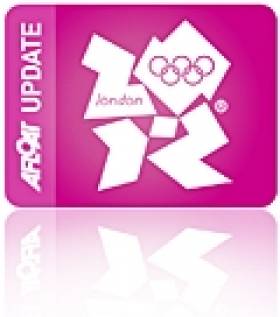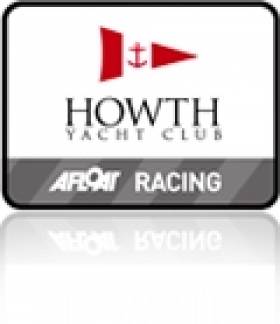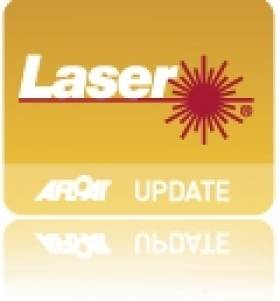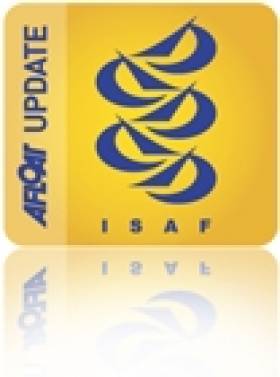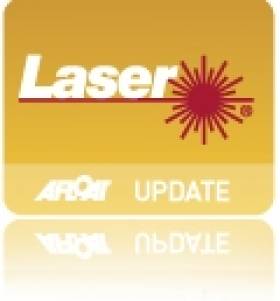Displaying items by tag: Laser
Annalise Murphy is Miami Medal Prospect
The strong Dun Laoghaire girl relished the prospects of the big winds that blew at times on Biscayne Bay this week. Consistent results of 5, 15, 2, 2, 5, 6 11,9, (21) and 5 never saw her out of the top five.
Tuesday saw her bag two second places in a fleet of 58. It was a turning point in a regatta that she crashed out of last year only to return wth grit to be Ireland's only medal hope today.
Last night's move up to fourth overall on the scoreboard is another confidence boost, heightening the prospect of a place on this evening's podium. Conditions in Miami today are forcast to be light, probably not the conditions the National Yacht club girl would have hoped for.
In the Star Peter O'Leary and his crew for his London 2012 bid David Burrows finished with a strong fifth place yesterday but it was not enough to make today's final. They finished 13th overall after counting a black flag disqualification on day two of the event. See all results HERE.
Rival to Annalise, Tiffany Brien from Belfast Lough finished 21st overall.
Her club mate Jame Espey was 49th out of 52 after 7 races in the Laser gold fleet.
More from Miami organisers below:
Waking to a brisk northwesterly breeze, sailors at US SAILING’s Rolex Miami OCR yesterday made up for races lost to light air Wednesday. The conditions, though chilly by Florida standards, played out perfectly for medals to be determined in three Paralympic classes, while 10 Olympic classes fought their final battles for the right to compete in tomorrow’s medal races, which are comprised of top-ten “sail-offs” for Finn, 49er, Men’s 470, Women’s 470, Laser, Laser Radial, Men’s RS:X, Women’s RS:X and Star classes, and Finals and Petit Finals for Elliott 6m (women’s match racing). The regatta, which began Monday for 716 sailors from 53 nations, prepares Olympic and Paralympic sailing aspirants for the 2012 Games and is the second of seven stops on the International Sailing Federation (ISAF) Sailing World Cup circuit.
For France’s Damien Seguin, a two-time 2.4mR IFDS World Champion who is currently ranked #1 in the world, winning gold in the Paralympic 2.4mR class was looking good from day two when he assumed the lead over his 30-boat fleet. Clinching today, however, was not as straightforward as today’s scores seemed to reflect. Following seven boat lengths behind leader USA’s John Ruf (Pewaukee, Wis.) at the finish in race one, Seguin was determined the actual winner when Ruf was disqualified for starting the race prematurely and neglecting to exonerate himself. “After that, for my next two races, my score was such that I needed only to loosely cover Thierry Schmitter (NED),” said Seguin, further explaining that only if he finished worse than sixth would he foil his own plot. Schmitter, another IFDS World Champion, took the Silver Medal, finishing fourth in the first race and winning the next two, each time with Seguin behind in second.
“There were many different winds here,” said Damien about the practice this provides for his run for a spot on the French national team. “We started in strong wind, then there was light wind and today medium-strong. I am very happy for that and for the competition.”
Taking bronze was Canada’s Allan Leibel, who is able-bodied and allowed to compete here, since the class is declared “open” for this event.
The Gold Medal taking in the Paralympic Sonar class by GBR’s John Robertson/Hannah Stodel/Steve Thomas came with an intriguing twist today. With two races completed, the Dutch team of Udo Hessels/Mischa Rossen/Marcel van de Veen were in the lead, and surprisingly, they did not sail the third and final race.
“There were two points between us and the Dutch, so no one will ever know how it would have played out on the water,” said Robertson, explaining that he understands Hessel’s middle crew Rossen, a single-arm amputee, had been having problems with his opposite shoulder and the team had decided beforehand to race no more than two races today.
Robertson’s team, which took the Silver here last year, posted a final score of 30 to the 36 points posted by silver medalists Bruon Jourdren/Eric Flageul/Nicolas Vimont Vicary (FRA). The Dutch team, with 37 points, is going home with the Bronze.
As for his team’s overall strategy here, Robertson said, “We tried to sail our own race and not get hung up with the other guys. Hanna did a fantastic job calling tactics, especially today, as the wind was up and down and all over the place, with 40-50 degree shifts.”
The Australian Paralympic SKUD 18 team of Daniel Fitzgibbon/Liesl Tesch has led their fleet since day one and boasted six victories in their nine-race score line to take the Gold medal. Today they finished 1-1-2.
“We didn’t walk away with it, really, but we were comfortably ahead,” said Fitzgibbon, who won a Paralympic Silver Medal (with a different crew) in Qingdao. "We didn’t expect to have done so well with such a new combination,” he added, noting that he and Tesch, who gave up Paralympic basketball (she is a two-time medalist) for her new-found love of sailing, have only been together on the SKUD 18 for a few weeks. “It’s a new challenge for her and a breath of fresh air for everybody.”
Taking Silver was US Sailing Team AlphaGraphics’ Scott Whitman/Julia Dorsett (USA), with Alexandra Rickham/Niki Birrell (GBR) taking the Bronze.
Medal Races Tomorrow
Top-ten finishers from today in each of nine Olympic classes will get only one chance--a 30- to 40-minute race—to make or break their claim to a podium position. Emulating the Olympic format, the medal race counts double points and cannot be counted as the one allowed discard race when it is added to a sailor’s score line from the rest of the series.
In women’s match racing, US Sailing Team AlphaGraphics members Anna Tunnicliffe(/Molly Vandemoer/Debbie Capozzi (Plantation, Fla., USA/Redwood City, Calif./Bayport, N.Y., USA) will meet Claire Leroy/ Elodie Bertrand/Marie Riou (FRA) in a first-to-three points Finals match tomorrow to determine Gold and Silver medalists. Lucy Macgregor/Mary Rook/ Kate Macgregor (GBR) and Sally Barkow (Nashotah, WI., USA)/ Alana O’Reilly (Charleston SC, USA)/ Elizabeth Kratzig-Burnham (Miami Beach FL, USA) will be fighting for bronze in the Petit Finals.
Match racing starts on its own course at 9:30 tomorrow, with fleet racing starting at 11:00 am on two additional courses. Fleet races are planned to be approximately 30 minutes in length and started 40 minutes apart. No racing will start after 1:40 p.m., so it will be an early day.
US SAILING has partnered with the city of Miami to provide world-class venues for competition. Additional hosts for the event include Coral Reef Yacht Club, Key Biscayne Yacht Club, Coconut Grove Sailing Club, Miami Rowing Club and Shake-a-Leg Miami. These sailing organizations host classes onshore, as well as help run the on-the-water racing. The Coral Reef Yacht Club also hosts the Opening and Closing Ceremonies.
In addition to title sponsor Rolex Watch U.S.A., US SAILING’s 2011 Rolex Miami OCR is also sponsored by AlphaGraphics, Gowrie Group, Chubb Insurance, Sperry Top-Sider, Harken McLube, Trinity Yachts, University of Miami Hospital and Kattack.
A complete roster of competitors can be viewed at the event website, RMOCR.ussailing.org, where real-time racecourse blogging, commentary and fan interaction, regatta results, photos and news updates will be integrated into a live coverage platform once racing begins. Video highlights produced by Gary Jobson and presented by Rolex air daily and are available on-demand on the event website. Fans can also follow the event on Facebook/RolexMiamiOCR and Twitter/RolexMiamiOCR.
More in our Olympics 2012 category HERE
Murphy Moves into Third in Miami
Two seconds in today's Laser Radial racing on Biscayne Bay give Dun Laoghaire's Annalise Murphy third overall at Miami Olympic Classes Regatta but the news in the Star class is not as good after Ireland's Peter O'Leary and David Burrows nosedive after a Black Flag Disqualification in race four.
Single hander Murphy, from the National YC, is racing in a highly competitive 58-boat fleet that is led by Belgium's Evi Van Acker. Winds over 16 knots ideally suited the National YC sailor wh now counts a 5, 15 and the two second places. Results HERE.
O'Leary and Burrows dropped from fourth to 23rd after counting a 28th and the Black Flag result today in their 56-boat fleet. Results HERE.

Annalise to leeward in a start in great conditions in Miami. Photo: Daniel Forster/Rolex
Sheridan Wins HYC Laser Race
HOWTH YACHT CLUB. LASER FROSTBITE SPRING (O'ALL) 23/01/2011 LASER STANDARD: 1, Daragh Sheridan HYC (16.00); 2, Evan Dolan NYC (18.00); 3, David Quinn HYC (19.00); LASER STANDARD APPRENTICE: 1, Conor Murphy HYC (6.00); 2, Darach Dineen HYC (12.00); 3, Conor Hopkins HYC (17.00); LASER STANDARD MASTER: 1, Evan Dolan NYC (12.00); 2, David Quinn HYC (12.00); 3, Daragh Kelleher SSC (13.00); LASER STANDARD GRAND MASTER: 1, Daragh Sheridan HYC (5.00); 2, Robin Hegarty HYC (11.00); 3, Conor Costello MYC (19.00); LASER RADIAL: 1, Robert Ferris HYC (8.00); 2, Vincent Varley MYC (8.00); 3, Ciaran Costello MYC (23.00)
Dolan Beats McMahon in Howth Yacht Club Laser Race
Greagsbey Wins in Howth
Nicholas O'Leary is Afloat's November Sailor of the Month
Nicholas "Nin" O'Leary of Cork has re-written the Irish sailing records, and he's only 24. The new All Ireland Champion Helm is clear winner of the Afloat.ie/Irish Independent "Sailor of the Month" award for November after a nail-biting finale in difficult conditions off Kinsale, making it three-in-a-row for this junior skipper who was winning major titles with impressive scorelines well before he was out of his teens.
The wind was drawing from the east for the 20th November shootout in the ISA's SailFleet of J/80s. But the challenge lay in the fact that, after a week of strong winds up to gale force, a massive swell was rolling in past the Bulman Buoy to provide sea conditions which were out of sync with the strength of the breeze.
Yet the three top Royal Cork helms showed they were up to the challenge. In fact, it was Neil Kenefick, in the championship through being tops in the ICRA series in 2010, who best got to grips with the racing in the early stages, posting two wins with Anthony O'Leary second in the first race, while son Nicholas was second in the next one.
But the junior O'Leary moved nearer to retaining the title by winning the third, though his father was right there with a second, while James Espey from the Lasers posted a third. However, Kenefick was in touch with a fourth, but that became his discount as he nailed a couple of thirds in the two concluding races.
Going into the fifth and final race, the three Crosshaven helms were neck-and-neck on points, but O'Leary Junior put it neatly away by slicing in ahead of his father, with Kenefick third. The Corkmen were out on their own, as next in line was Puppeteer 22 Champion Garret May, but he concluded with 18 net points, while Neil Kenefick was on 8, Anthony O'Leary on 7, and Nicholas O'Leary the supreme champion on 6. And making a bit of history while he was at it - the first three-in-a-row in the All Ireland's 64 years.
Greagsbey in Front at Howth Laser Frostbtes
No Recommendation for Mens Keelboat Poses Problem for Star
There was big news yesterday from the ISAF events committee meeting in Athens. The conference blog reports A 'packed session' heard the Events Committee's recommendation on the provisional Olympic events and equipment for 2016.
The Events Committee recommends:
- Board or kite-board for men and women - equipment evaluation
- One person dinghy men - Laser Standard
- One person dinghy women - Laser Radial
- Two person dinghy (skiff) men - 49er
- Two person dinghy (skiff) women - equipment evaluation
- Second one person dinghy men - Finn
- Two person mixed multihull - equipment evaluation
- Two person mixed dinghy with spinnaker - 470
- Women's keelboat - Elliott 6m
In so doing the committee's voting recommends taking out the men's keelboat. The second one person dinghy for women was the other option not to be selected.
The Committee's recommendations are of course just that. They will go to the ISAF Council for consideration this weekend. After Council vote they are then subject to confirmation at the ISAF Mid-Year meeting in May 2011.
McMahon and Hegarty Win HYC Laser Races
HOWTH YACHT CLUB. LASER FROSTBITE WINTER 07/11/2010 RACE 1 LASER STANDARD: 1, Paul McMahon HYC; 2, Conor Greagsbey NYC; 3, Darrell Reamsbottom HYC; 4, Conor Murphy HYC; 5, Daragh Kelleher SSC; 6, Stephen Quinn HYC; LASER STANDARD APPRENTICE: 1, Conor Murphy HYC; 2, Brendan Costello MYC; 3, Brian Tyrrell HYC; 4, Conor Hopkins HYC; LASER STANDARD MASTER: 1, Paul McMahon HYC; 2, Conor Greagsbey NYC; 3, Darrell Reamsbottom HYC; 4, Daragh Kelleher SSC; 5, David Quinn HYC; 6, Evan Dolan NYC; LASER STANDARD GRAND MASTER: 1, Stephen Quinn HYC; 2, Robin Hegarty HYC; 3, Daragh Sheridan HYC; 4, Cathal Sheridan MYC; 5, Dermot Mowatt HYC; 6, Alan Carr SDC; LASER RADIAL: 1, Darragh Peelo MYC; 2, Vincent Varley MYC; 3, Robert Ferris HYC; 4, Simon Revill HYC; 5, Ciaran Costello MYC; 6, Carla Fagan
HYC LASER FROSTBITE WINTER 07/11/2010 RACE 2 LASER STANDARD: 1, Robin Hegarty HYC; 2, Colm Cunningham HYC; 3, Conor Greagsbey NYC; 4, Paul McMahon HYC; 5, Conor Murphy HYC; 6, Stephen Quinn HYC; LASER STANDARD APPRENTICE: 1, Conor Murphy HYC; 2, Conor Hopkins HYC; 3, Brendan Costello MYC; 4, Brian Tyrrell HYC; LASER STANDARD MASTER: 1, Colm Cunningham HYC; 2, Conor Greagsbey NYC; 3, Paul McMahon HYC; 4, Darrell Reamsbottom HYC; 5, Richard Deane HYC; 6, Evan Dolan NYC; LASER STANDARD GRAND MASTER: 1, Robin Hegarty HYC; 2, Stephen Quinn HYC; 3, Dermot Mowatt HYC; 4, Conor Costello MYC; 5, Daragh Sheridan HYC; 6, Edward Ferris HYC
Finn Fights to Stay Olympic Dinghy Class
The Council are going to be asked to confirm six core events and these it is understood will most likely will be Men and Women Boards, Laser and Laser Radial and Men and Women Skiff.
Once these are selected the other four events will be considered and the Olympic Commission has suggested that 4 of the following 6 be picked:
Men's Heavyweight (Finn)
Women's other weight division in singlehanded
470 mixed
Multihull mixed
Men's Keelboat
Womens Keelboat
With the commission recommending equal gender balance, the Finn is unlikely to stay on its own and would need another women's singlehander to be selected.
The multihull is almost certain to get in, and there probably will be strong support for men and women's keelboat leaving it to be fought out between the Finn, the 470(mixed) and a Women's single handed dinghy.
Many believe the second decision will be deferred until May, but as one ISAF insider told Afloat.ie "I would be selling my Finn now if I had one".
Meanwhile the Finn class association don't see it that way at all. Under the threat of possible deselection the heavyweight men have been mobilising for a fight. Below are details of its recent campaign to stay an Olympic boat. Scroll down for nice Video too.
International Finn Association Press Release
The Finn - an outstanding display of sailing skills and athleticism
The Olympic Commission set up by ISAF delivered its preliminary report at the ISAF Conference in May 2010. Based largely on the Olympic Commission report, the ISAF Executive has since published two submissions which outline an exciting new future for the selection and decision making process for Olympic sailing events and equipment. The Finn is positioning itself to be part of that future.
Among the submissions are proposals for two sets of single-handed dinghies for both male and female sailors, to represent the weight and size distribution of modern youth of both genders in the most popular and low-cost type of dinghy sailing. The Finn class supports this idea.
Here are some of the arguments why Finn sailors think the Finn should remain part of the Olympic sailing equipment.
Tough challenge
The Finn is widely regarded as one of the toughest physical challenges in sailing. Sailors have to be tough, strong, fit, agile and athletic, while managing the mental aspects of racing at the highest level. The current world champion has a VOR max comparable with marathon runners and cross country skiers. Winning takes dedication, commitment and performing at the limits of fitness and endurance.
Appealing racing visuals
Modern looking rigs and hulls. Beautiful boat to sail with athletic, fit, muscular sailors. Requires extreme physical effort to sail well. Golden sail insignia for former world champions from 2011. Continuing research into sailor identification and country flags on sails. The free pumping rule has transformed downwind sailing into an absorbing display of skill, strength and athleticism.
Standard boats
Finns can be bought 'off-the-shelf' and be winning the next day. Hulls, masts and sails have all evolved into a level plateau of standardisation that means boats can compete on a level playing field. The strict class rules limits any experimentation into 'super' boats. Boats that are sold year after year are identical within reasonable limits and do not change perceivably over time.
Low costs
The Finn has one of the lowest running costs of any Olympic equipment. Average campaign costs from 35 sailors was just EUR 7,500 a year. One boat can last at least two Olympic cycles. Gear standardisation has meant reduced development costs. Gear is fast and ready to sail 'out of the box'. Increasing IHC and building control is reducing regatta measurement requirements, while 99% of checks at regattas pass first time.
Consistent equipment
Today's Finns are the most consistent, accurate and reliable Finns ever built. A modern Finn can be expected to be competitive for 6-8 years. The Finn is one of the most consistent hulls made today, thanks to very professional builders and strict measurement rules. Modern materials and new technologies means that boats supplied all over the world are as alike as possible in almost every way.
Easier rules
A proposal was passed at the 2010 AGM to lower the free pumping limit to 10 knots. This was aimed to make Rule 42 enforcement easier for judges and sailors. Under 10 knots there are much less opportunities for pumping and surfing. Identifying illegal activity is much easier, so less emphasis on judging decisions. Sailors are educated in Rule 42 – frequent clinics with the active involvement of judges and website coverage.
Worldwide culture
Local builders are producing low cost Finns for regional competition. Having been on the Olympic Programme since 1952, the Finn has the deepest culture and traditions of any dinghy class. Semi-professional class organisation oversees all activities. All levels of competition from Juniors (U21) to Masters (40+) and everything in between. Many countries are developing Junior programmes to fast track talented sailors.
Global spread
Finns are now built in the UK, Poland, Hungary, Czech Republic, Brazil, USA and South Africa, and there are other countries to come. Elsewhere, suppliers and dealers feed local fleets with new and used equipment. There are National Finn associations in more than 50 countries, while between 35 and 40 countries have internationally active sailors. Sailors from six continents attend major regattas. It is truly a global fleet.
Pinnacle event
The Finn is the pinnacle of singlehanded dinghy sailing for men, and the Olympics is the pinnacle event for the Finn. It provides a single step pathway from Optimist to Laser to Finn as the sailor's weight increases, but also allows the development of similar technical and physical skills in the sailor through a natural progression of similar equipment.
What the sailors say:
Jonas Høgh Christensen (DEN), 2006, 2009 World Champion, "The Finn is the most fun, challenging boat for strong, athletic sailors."
Giorgio Poggi (ITA), 2008 Finn Olympian, "The Finn is the class where the sailor must be complete."
Zach Railey (USA), Silver medalist, 2008 Olympics: "For single handed sailing the Finn is my only option given my weight and height to pursue my Olympic sailing dreams. With the technical and physical demands of the boat, the Finn is a pure test of a sailor's ability to react to the changing conditions on the race course under intense physical exertion."
Rob McMillan (AUS), "There is no other boat like it. The advent of free pumping brings a level of athleticism that is unique to the Finn."
Daniel Birgmark (SWE), 4th 2008 Olympics, "Sailing the Finn puts very high demands on the sailors athletic capacity as well as tactical and strategic skills. It's the perfect singlehander for sailors over 85kg."
Tomas Vika (CZE), one of many Finn sailors in their early 20s, "If you are more than 180cm tall and you want to work on your physical condition in a gym you will always weigh more than 85kg and that is the reason why Finn has to stay as an Olympic dinghy in future years."
Gus Miller (USA), Finn legend: "It's a very powerful demanding boat and you need a lot of initiative and attitude that you're going to do it yourself. Everyone realises the challenges is yourself not the other guys. The challenge is the boat and that understanding is the old idea "I love my competitor because he makes me better". The guys here have enormous respect because the challenge of sailing the boat is so great. If one guy figures it out then the others guys are glad for him that he's been able to do it."
Caleb Paine (USA), first Junior, 2010 Finn Gold Cup: "The Finn is the best class I have sailed in. There isn't I class I know of that has such a great sense of camaraderie. After my first international regatta I knew all the best Finn sailors in the world on a first name basis because they were open, friendly and supportive of the new kid. I think that this coherence of the class stems from the fact that the sailors often train together. This builds friendships as well as making everyone better."
Tapio Nirkko (FIN), 2008 Finn Olympian: "The Finn is already well developed in many areas. We're now in a situation when all the Finn equipment (hull, mast, boom, rudders, centreboards) are good quality and last a long time. When the market is competitive, the price of the equipment is also fair and resale value is good. That's an important factor to make a competitive Olympic project from a small country with a small budget. Now the actions made in the class to make equipment issues more transparent is important to keep Finn as a class where it's possible to make it to the top without having a monster budget."
Ed Wright (GBR), 2010 World Champion, on what makes the Finn class special for him: "For a start it's visually pleasant. The cost is low. I still use my first mast and it's still fast after five years. .... You can gain little advantages everywhere, but you have to treat the Finn with finesse, respect and grunt to keep it up to speed. The people in the class are great people and all hard competitors. Also there is so much history in the class, and never forget the many legends coming from the Finn."
Read more from these interviews and more about the Finn in the latest issue of FINNFARE out now


























